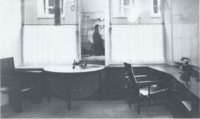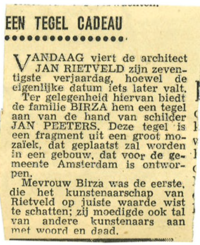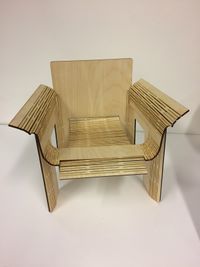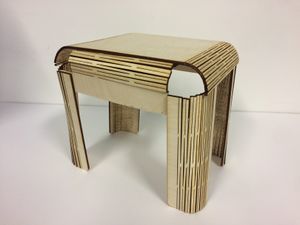Difference between revisions of "User:0927758"
| Line 1: | Line 1: | ||
Charlotte Birza, 0927758 | Charlotte Birza, 0927758 | ||
| + | For my Reflection Document see Osiris. | ||
---- | ---- | ||
Revision as of 12:40, 7 June 2018
Charlotte Birza, 0927758
For my Reflection Document see Osiris.
Digital Craft: The Birza-chair by Gerrit Rietveld
Gerrit Rietveld and the Birza-family
For this practice, Digital Craft, I chose to work with the Birza-chair by Gerrit Rietveld. I first heard about Rietveld when my father told me that this famous architect designed and built a room for my great-grandparents in their house in Amsterdam.
At the time Rietveld was not yet a famous architect. My great-grandparents enjoyed buying work by young artists. Their son, my grandfather, inherited the Birza-room from his parents. The pieces of furniture included the Birza-chair. This chair was designed in 1927. Rietveld tried to design a chair, made out of one piece of material, that could easily be factory-produced. It is made of fiber. The production-process was so complicated and cost so much time, that only one was built.
The room doesn’t exist anymore. After my great-grandparents moved most of the interior of the Birza-room stood in the house of my grandparents. My father told me it was not suitable for daily use because the furniture was very vulnerable.
In 1986 my grandparents offered the furniture in their possession to the Gemeentemuseum in The Hague. The Gemeentemuseum appeared only moderately interested. On hearing that the furniture would not be put on display and would be kept in storage, my grandparents decided to put it up for auction at Christie’s in Amsterdam. This auction created much publicity, as it was the largest collection of Rietveld-furniture ever to be auctioned.
This story about Rietveld and the Birza-family was so interesting that it triggered me to research Rietveld and the part my great-grandparents played in the discovery of this architect. I started my research in our cellar at home. In a box I found various interesting pieces of Rietveld-material. I found correspondence from Rietveld to my great-grandparents, a design for a double grave for my great-grandparents, samples of waterproof wallpaper (very unusual for 1930), a garden-design and a few designs for furniture.
- Letters from Rietveld
I found correspondence between 1927 and 1958. One can read about the friendly relationship between my great-grandparents and Rietveld. He frequently writes about visiting them. In a letter dated November 15, 1929 Rietveld writes, that ‘The Chair’ has undergone many changes. He has started working on it again. He writes: ‘I hope you are not offended that I started experimenting again on your chair. It has been drastically pruned. I shall finish it shortly and send it to you (it is taking too long).
On September 6, 1950 Rietveld writes about the Birza-room: ‘It was one of the coolest interiors I made and when revisiting it I was always surprised by the suggestion of space it gave. I must say you also supported the colouring well with your choice of paintings and drawings. My congratulations on your becoming grandparents. If you ever want to get rid of the fiber chair I would like to make a first offer. R.’ The grandchild he mentions is my father.
On April 18, 1954 Rietveld writes: ‘…. My work for you was of little consequence. Payment is absolutely not necessary; you were one of the few, who in times, when our work was still strange to people, had trust. That has been more than enough payment.’
Who was Gerrit Rietveld?
Gerrit Thomas Rietveld was born on June 24 of 1888. Like his father he was a cabinet maker. Later he became an architect. Al his life he lived in Utrecht. He became famous for The Rietveld –Schröder house and his chairs. Until his death on June 25, 1964 he worked as an architect and designer. He was always in search of new possibilities. It is often thought that Rietveld thought of the red-blue chair and the Rietveld-Schröder house overnight. This is certainly not true. His designs were often the result of much experimentation.
It was important to Rietveld that many people could buy his designs. Therefor he used cheap materials. He tried to find ways in which his furniture could be factory-produced. He experimented with methods too. He wanted to design furniture and houses, that could be produced industrially. Only a few of his houses were ever built. In the twenties and thirties Rietveld was appreciated, as a person, as an architect and as a designer of furniture. The simplicity of his work was seen as liberating. Rietveld was always experimenting with materials. It not always occurred to him, that his designs should also be practical in use. The criticism that was the result did not interest him. He saw the criticism as proof of being on the right track. In the periodical ‘De Stijl’ nr. 46 (1927) he wrote. ‘Every true creation…. changes the insight, the demands and the needs of its time and clashes with the prevailing demands and needs of previous periods. A creation must therefore gain the position instead of falling in with the prevailing demands and the necessity’.
Design characteristics
In his designs Rietveld used straight lines and planes. He didn’t use no ornamentation. Everything was simple. He wanted to show how things are made.
His designs were not always practical. Comfortable use was less important. ‘De Stijl’ and ‘Het Nieuwe Bouwen’ helped Rietveld reduce everything to the simplest elements. In making his furniture Rietveld was in search of different techniques to make connections.
Conclusion
Rietveld is known for his house and his chair. The availability of his furniture and his houses was important to him. Whether they were practical in use was of less interest. He once said when someone complained about the hardness of his chairs: ‘If you are tired you must go to bed’.
With his designs, which were very different from what people were used to at the time, he has made people look differently at furniture and houses.
I think my great-grandparents only contributed a little bit to Rietveld becoming well known. Their commission is only one in a long list of Rietveld’s work. The auctioning of the Birza-room on the other hand caused a lot of publicity because it was exceptional for so many pieces of furniture designed by Rietveld to be sold on a single occasion. I suppose the Gemeentemuseum regrets its decision not to accept the offer of my grandparents because of the condition to put the furniture on display.
Copy and transformation
It was very enjoyable to look though the material of Rietveld we have in our possession. Reading the correspondence was a special experience.
I investigated the Birza-room with special attention to the Birza-chair. This chair is made of one piece of fibre-material. I asked myself how I would be able to make a chair like that. Is it easier with modern techniques? Is it possible with the use of a laser cutter? The copy I made of the chair is also made from one piece of material. I took the design of the chair from the site of the Stedelijk Museum in Amsterdam and started thinking of a way to fabricate this chair with the use of a laser cutter. During this process I discovered I did not know how big the flexible parts in the chair should be to be able to bend the plywood. When I made the first model I made the flexible parts to small. As a result the plywood could not be bent far enough.
For the next model I made the flexible parts bigger. This model could be bent far enough but it was still difficult to put it all together. I am sure Gerrit Rietveld also encountered this problem.
I also found that the blueprint I used did not correspond completely with the chair we now know. The seat is to deep causing it to stick out.
- Copy Birza-chair
Finally I wanted to make a flexible design following Rietveld’s idea for the Birza-chair. To transform the chair I decided to make a stool. The most difficult part turns out to be making a design with big flexible parts and still make it strong enough to stand firm. The flexible parts make the material fragile. I understand Rietveld’s idea about experimenting with furniture made out of one piece of material. I immediately understood the difficulty in making a stool and easy to assemble design. I now see why only one Birza-chair was made. After having built the Birza-chair cabinet maker V.d. Groenekan is supposed to have said: ‘Never again! I gave it a go but I think Ikea is better.
- Transformation Stool
















